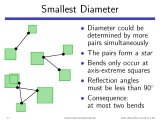Largest Bounding Box, Smallest Diameter, and Related Problems on Imprecise Points
Imprecision of input data is one of the main obstacles that prevent geometric algorithms from being used in practice. We model an imprecise point by a region in which the point must lie. Given a set of imprecise points, we study computing the largest and smallest possible values of various basic geometric measures on point sets, such as the diameter, width, closest pair, smallest enclosing circle, and smallest enclosing bounding box. We give efficient algorithms for most of these problems, and identify the hardness of others.
keywords: Computational Geometry, Data Imprecision
Journal Article (peer-reviewed)
Maarten Löffler, Marc van Kreveld
Largest Bounding Box, Smallest Diameter, and Related Problems on Imprecise Points
Computational Geometry: Theory and Applications
43, 4, 419–433, 2010
Conference Proceedings (peer-reviewed)
Maarten Löffler, Marc van Kreveld
Largest Bounding Box, Smallest Diameter, and Related Problems on Imprecise Points
Proc. 10th Workshop on Algorithms and Data Structures
LNCS 4619, 447–458, 2007
Invited to Special Issue of CGTA
Technical Report (not reviewed)
Maarten Löffler, Marc van Kreveld
Largest Bounding Box, Smallest Diameter, and Related Problems on Imprecise Points
UU-CS-2007-025, 2007
back to list
